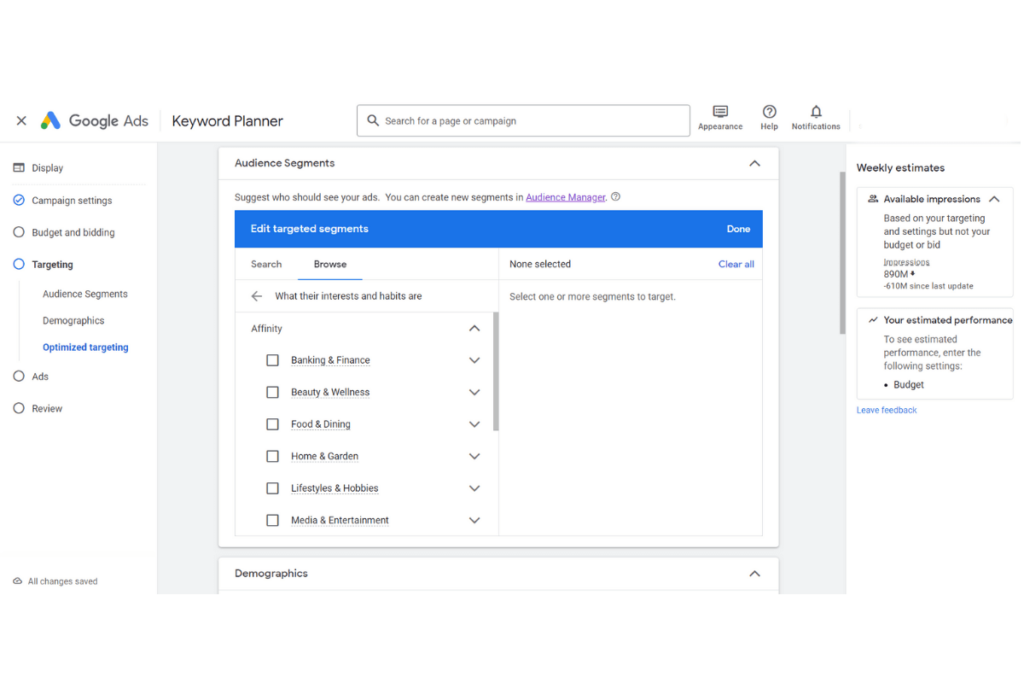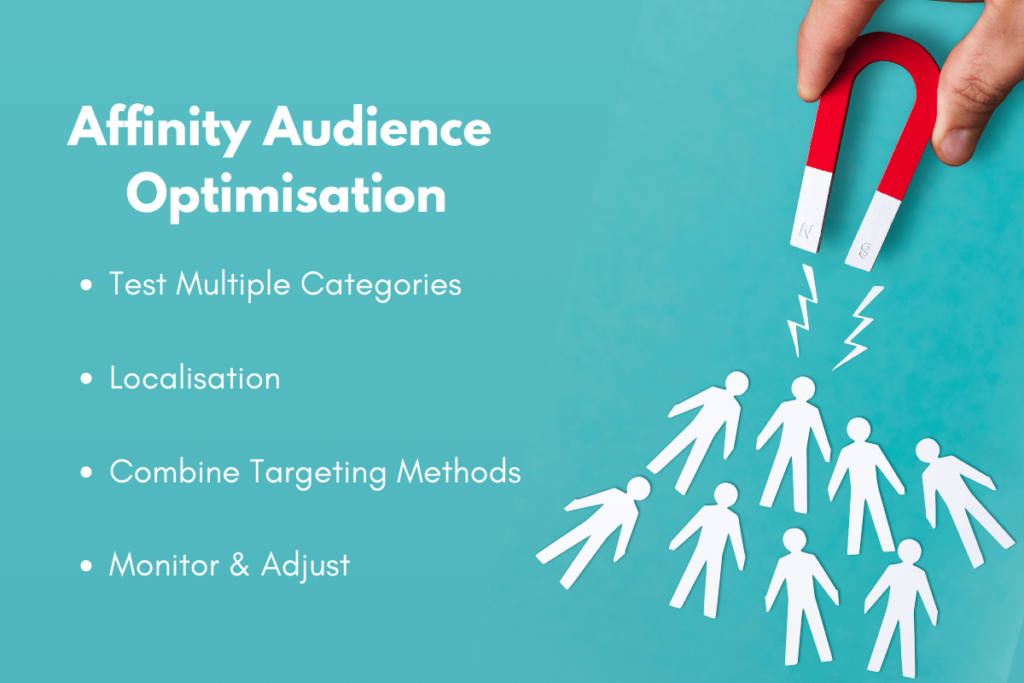Australia has a thriving online marketplace, presenting enormous opportunities for businesses to target potential customers effectively. One of the most powerful tools available for targeting relevant users is Google Ads, and within that, one of the most efficient features is Affinity Audiences.
But what exactly are affinity audiences in Google Ads, and how can Australian businesses make the most of them? This article will delve into the concept of Google Ads Affinity Audiences, how to optimise affinity audiences with Google Ads, and the finer points of affinity audiences optimisation. Helping you pinpoint new potential customers for your campaign launch in Australia while growing your revenue and boosting your conversion rate.
What Are Affinity Audiences in Google Ads?
Affinity Audiences in Google Ads are designed to help businesses reach potential customers who have already shown a strong interest in a related topic or product. Google’s algorithms take into account users’ browsing history, search patterns, and other online activities to categorise them into various ‘affinities’ or interest groups. The idea is to show your ads to people who are not just in the market for a product at that moment, but those who have a long-term interest in your industry or service.
For example, if you sell camping gear, Google Ads may identify users who regularly visit hiking blogs, search for national parks, or watch outdoor adventure videos as part of an ‘Outdoor Enthusiast’ affinity audience.
How to Use Custom Affinity Audiences?
Custom Affinity Audiences take the game to a whole new level. Instead of relying solely on predefined categories, businesses can customise their audiences based on specific interests, keywords, URLs, and more. This offers a more nuanced approach to targeting relevant users.
To create a custom affinity audience, follow these steps:
- Go to the ‘Audiences’ section in Google Ads.
- Click on ‘Audience Segments’.
- Choose the ‘Affinity’ option.
- Enter the relevant interests, URLs, or apps that relate to your target audience.

Examples of Affinity Audiences
- Tech Savvy: Users who are interested in technology, regularly read tech blogs or visit electronics stores online.
- Home Decor Enthusiasts: Individuals who often browse furniture websites, read interior design blogs, or search for home improvement tips.
- Adventure Travellers: Users who are interested in extreme sports, adventure holidays, and outdoor activities.
- Pet Lovers: Individuals who frequently visit pet care blogs, search for pet products, or watch pet care videos.
- Australian Sports Fans: A custom affinity audience that targets people interested in Australian Football League (AFL), rugby, or cricket.
Affinity Audiences Optimisation
Affinity audiences are powerful tools in the Google Ads toolkit, but like any tool, their effectiveness can be greatly amplified through optimisation. Here’s how to optimise for the best possible results when launching a paid ads campaign in Australia.
Test Multiple Affinity Categories
The first step in improving affinity audiences is to diversify your risk and opportunities by testing multiple affinity categories. This means running smaller, parallel campaigns aimed at different audience interests to understand which group is more responsive to your ads.
For example, if you are an online retailer in Australia selling outdoor gear, you might target both “Adventure Travellers” and “Outdoor Enthusiasts” as separate affinity audiences. You may find that one group is more engaged or more likely to convert, allowing you to allocate more of your budget to the more effective audience.
How to Implement: Start by identifying at least three to four potential affinity categories that align with your business. Run campaigns with a small budget initially and closely monitor performance metrics like click-through rates, conversion rates, and return on ad spend (ROAS).
Localisation
Australia has a unique culture, lingo, and set of references that can make a significant difference in how your ads are received. When optimising for an Australian audience, it’s crucial to use local language, colloquialisms, and cultural references to resonate more closely with your target users.
For instance, instead of using the term “vacation,” opt for “holiday” to make it more relatable to Australians.
How to Implement: A/B test different ad copies to gauge which local references or colloquialisms perform better. Monitor engagement metrics and tweak your ad copy based on what resonates most with your Australian audience.
Combine with Other Targeting Methods
While affinity audiences are potent, they are even more powerful when used in combination with other targeting methods like geographic or demographic targeting. For example, you could target “Pet Lovers” within a specific age group who also reside in Sydney to make your campaign even more targeted.
How to Implement: In the Google Ads interface, when setting up or editing a campaign, you can add multiple layers of targeting. Experiment with adding geographical limitations, age ranges, or even specific device types to see how these refinements impact your campaign’s performance.
Monitor and Adjust
The world of digital advertising is ever-changing, and what worked yesterday might not work tomorrow. Always keep an eye on key metrics like click-through rates (CTR), conversion rates, and average cost per click (CPC) to gauge the effectiveness of your affinity audiences targeting.
For Australian businesses, seasonality could be a crucial factor. For example, ads targeting ‘Beach Enthusiasts’ may perform better during the summer months. Monitoring allows you to make real-time adjustments to ensure that you’re always getting the best bang for your buck.
How to Implement: Make use of Google Ads’ detailed analytics to track your campaign’s performance. Set up custom alerts to be notified when there are significant changes in your key metrics.

Difference Between In-Market and Affinity Audiences
While both in-market and affinity audiences are designed to improve ad targeting, they serve slightly different purposes. In-market audiences are users who are actively researching or planning to buy a product or service, making them ideal for short-term campaigns that aim to convert quickly. On the other hand, affinity audiences are based on long-term interests and habits, making them ideal for building brand awareness and customer loyalty over a longer period.
The Bottom Line on Affinity Audiences in Google Ads
With the proper use of Google Ads Affinity Audiences, Australian businesses can tap into a rich vein of potential customers based on genuine interests and online behaviours. Custom affinity audiences add another layer of precision, allowing for even more targeted marketing campaigns. By understanding and implementing these features wisely, your business can reach the most relevant users in a competitive digital landscape.
Your Next Steps
Affinity audiences aren’t the only aspect of Google Ads you should be paying attention to before you launch a campaign in Australia. Take a look at our comprehensive tutorial on how to take advantage of in-market audiences as well as demographic targeting for your Google Ads campaign. Don’t forget about leveraging custom audience details to more precisely target your ideal audience.
If you need some extra help getting the most out of your Google Ads campaigns in Australia, contact our Adelaide-based Google Ads agency to schedule your free one-on-one sales consultation with our knowledgeable experts. See for yourself why we’re trusted with over 4 million in ad spend for some of the country’s leading brands.




